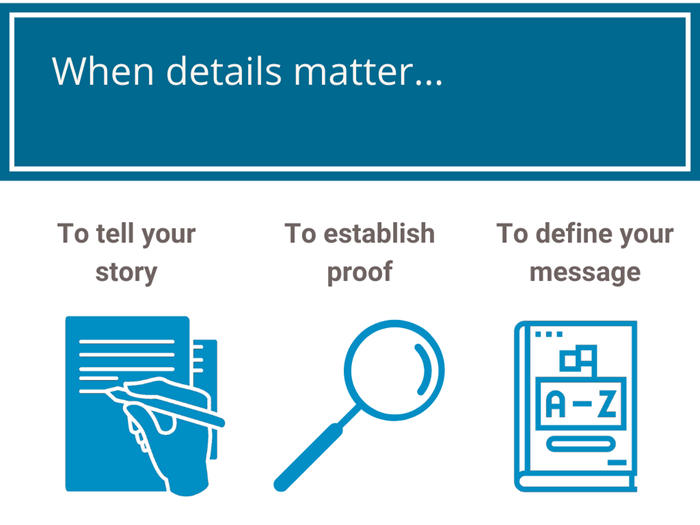 Business communication details have become the devil director of doomed business content. Eyes glaze over, coupled with the loud clicking of online escape.
Business communication details have become the devil director of doomed business content. Eyes glaze over, coupled with the loud clicking of online escape.
But details get a bad rap.
Communication without details is a meaningless shell of words. They add context and credibility. However, that does not mean we need to share EVERY SINGLE DETAIL.
So, how can you balance those devilish details for better business communication?
Tip: If you want to skip the details, jump to The Devil is in the Details video below.
Business Communication Details
Damned if You Do
The devilish side of business communication is knowing when details matter (as illustrated below) and when your level of details detract rather than help.
Tell Your Story
Storytelling is a proven technique for effective business communication. But imagine that story without details.
It’s like watching a movie with a plot twist that makes no sense.
- The audience is confused.
- They may feel cheated.
- Most will reject the story.
On the flip side, a story with too much detail casts the audience into Detail Hell.
- Do we really need a daily accounting of a product’s launch?
- A constant barrage of “coming soon” emails infuriates customers.
- Fewer announcements would do quite nicely, thank you.
So, the right level of details draws in your audience and guides them to a happy ending. They discover a product they want, and you cement your credibility.
Too many words sent too often flips the customer’s interest switch from on to off.
Establish Proof
One of my favorite quotes comes from Mark Twain’s Own Autobiography: The Chapters from the North American Review, where he quoted Disraeli.
Working with statistics gets tricky. Like words, too many statistics turn most readers off. However, statistics also confirm statements and lend proof.
Accurate statistics convert vague statements into credible resources.
That does not mean your audience needs (or wants) a slide or paper filled with statistics.
- Translate statistics for your audience
- Share what the statistics mean
- Use visuals to make your point
Historical details can act as another form of proof.
A company’s history establishes experience. A company that survived decades (or COVID) demonstrates at least some level of business savvy.
However, playing devil’s advocate, readers won’t plow through an annual analysis of the company, beginning with its start in 1892.
Share enough history to establish credibility but not so much that your audience stops caring.
Define Your Message
Your audience helps shape your message. But before you do any business communication, you must define your message. And details help you do that.
Defining your message may sound simple. However, too often we confuse goals and objectives with our message.
- I want to sell our product
- Nice objective, but not your message
- What is the point of your message?
Our widgets help customers who manufacture XYZ computer parts to produce them faster and better.
Ah, got it. Now prove it.
That’s where details help.
Using the litmus test for communication, define your message.
- Quickly make your point
- Answer how that benefits your audience
- Use details to build your case
- Summarize and restate your message
The Devil is in the Detail
The video below combines enough details (hopefully, not too much) with visual images to communicate this post’s message.
I updated the post’s prior SlideShare presentation to a video because I found the SlideShare format does not play nice with all browsers.
Do you feel a little better about details now? What details do you want to share? Please jot them down in Comments.
==================================
Note: In 2015, SSB took a year-long alphabetic journey for better business communication. Each post contained an A-to-Z topic for creating better business communication. This ‘D’ post originally published on March 2, 2015. This March 22, 2022 version updates it. The plan is to update each alphabetic post. Hopefully, it will not take a year to complete. 😊
===================================



Ah, balance… easy to say, tricky to define… helpful details here.
Thanks, Anne. It’s kind of like Goldilocks trying to find porridge that is just right. 😉
Statistics make my brain hurt, Cathy. All those percentages and percentiles make me crazy. I make it a point to avoid ever trying to summarize the meaning of someone else’s statistics. That means when I include statistics, I try to use them verbatim.
Like I said, Paula, statistics can be tricky. I cannot stand when they are skewed to make an invalid point. But then that’s just me. 😉
Cathy, I couldn’t agree with you more about the importance of defining your message. It so often gets missed!
Thanks, Kim. 🙂
And doing so with humor may help seal the deal.
Humor is always good in my book, Roy. 😉